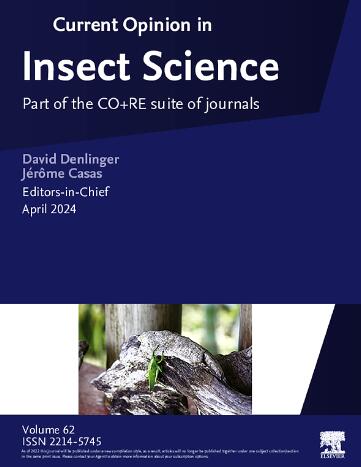昆虫性染色体进化:保存、更新和剂量补偿机制。
IF 4.8
1区 农林科学
Q1 BIOLOGY
引用次数: 0
摘要
性染色体在整个生命之树上进化了很多次,了解是什么塑造了它们不寻常的形态、序列和调节特征一直是一个长期的目标。大多数关于昆虫性染色体生物学的早期见解来自少数模式物种,如果蝇黑腹果蝇,这限制了大规模的进化推断。最近,广泛的比较基因组学研究发现了一些意想不到的模式,我们在这篇综述中强调。首先,我们描述了祖先X染色体超过4.5亿年的保存,但也描述了它在至少一个顺序上的周期性周转(即当新的X染色体出现时它向常染色体的逆转)。然后,我们总结了关于昆虫在Y染色体降解后如何调节x连锁基因表达的经典和最新发现,以及所确定的剂量补偿的多种机制如何阐明性染色体调节进化的重要原理。本文章由计算机程序翻译,如有差异,请以英文原文为准。
Insect sex chromosome evolution: conservation, turnover, and mechanisms of dosage compensation
Sex chromosomes have evolved many times throughout the tree of life, and understanding what has shaped their unusual morphological, sequence, and regulatory features has been a long-standing goal. Most early insights into insect sex chromosome biology came from a few model species, such as the fruit fly Drosophila melanogaster, which limited broad-scale evolutionary inferences. More recently, extensive comparative genomics studies have uncovered several unexpected patterns, which we highlight in this review. First, we describe the conservation of the ancestral X chromosome over 450 million years but also its recurrent turnover (i.e. its reversal to an autosome when a new X chromosome arose) in at least one order. We then summarize classical and more recent findings on how insects modulate the expression of X-linked genes following the degradation of the Y chromosome and how the diverse mechanisms of dosage compensation identified may elucidate important principles of sex chromosome regulatory evolution.
求助全文
通过发布文献求助,成功后即可免费获取论文全文。
去求助
来源期刊

Current opinion in insect science
BIOLOGYECOLOGYENTOMOLOGY-ECOLOGY
CiteScore
10.40
自引率
1.90%
发文量
113
期刊介绍:
Current Opinion in Insect Science is a new systematic review journal that aims to provide specialists with a unique and educational platform to keep up–to–date with the expanding volume of information published in the field of Insect Science. As this is such a broad discipline, we have determined themed sections each of which is reviewed once a year.
The following 11 areas are covered by Current Opinion in Insect Science.
-Ecology
-Insect genomics
-Global Change Biology
-Molecular Physiology (Including Immunity)
-Pests and Resistance
-Parasites, Parasitoids and Biological Control
-Behavioural Ecology
-Development and Regulation
-Social Insects
-Neuroscience
-Vectors and Medical and Veterinary Entomology
There is also a section that changes every year to reflect hot topics in the field.
Section Editors, who are major authorities in their area, are appointed by the Editors of the journal. They divide their section into a number of topics, ensuring that the field is comprehensively covered and that all issues of current importance are emphasized. Section Editors commission articles from leading scientists on each topic that they have selected and the commissioned authors write short review articles in which they present recent developments in their subject, emphasizing the aspects that, in their opinion, are most important. In addition, they provide short annotations to the papers that they consider to be most interesting from all those published in their topic over the previous year.
 求助内容:
求助内容: 应助结果提醒方式:
应助结果提醒方式:


